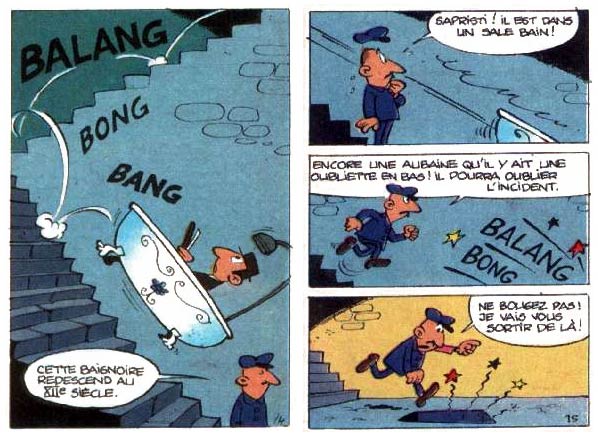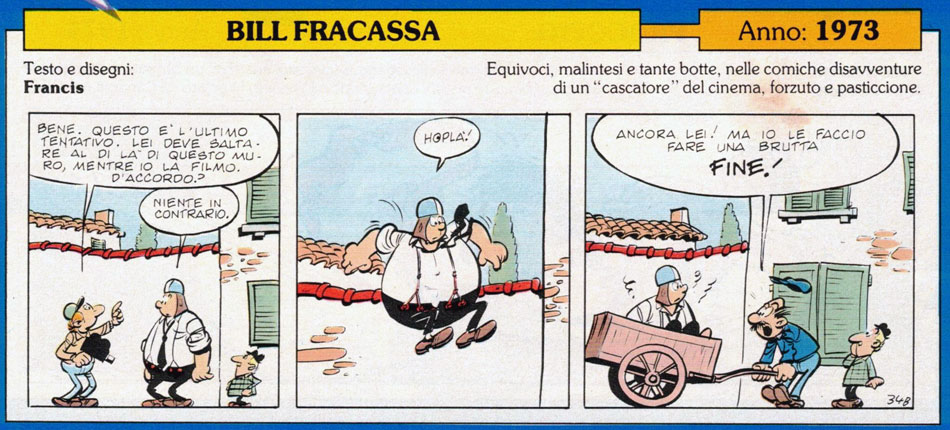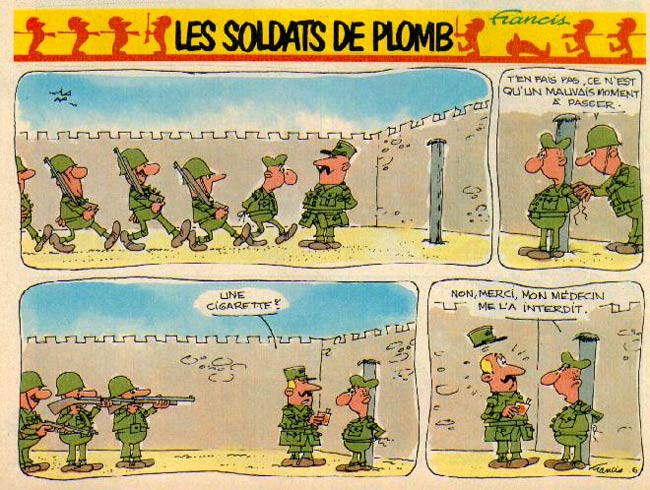Francis Bertrand, who published under only his first name, drew humorous comics for several newspapers and magazines, but most notably Spirou. Graphically a follower of that magazine's "School of Marchinelle", Bertrand's comics were characterized by their slapstick humor and verbal comedy. His passion for classic American cars was well represented in his work, most notably in his signature series 'Marc Lebut et son Voisin' (1966-1986), about the exploits of two bickering neighbors and a Model T-Ford.
Early life and career
Francis Bertrand was born in 1937 in Uccle, a bilingual municipality in the Brussels region. His father was a painter specialized in marine and Mediterranean sceneries. Francis inherited his father's talent for drawing, but also developed a keen interest in cars, especially oldtimers (antique cars). He combined his two hobbies for the first time in the comic strip 'Plein Gaz' (1957), published in the newspaper La Cité, starring a race car driver called Many-Vaile. He spent one year at the Academy of Fine Arts in Brussels, and fulfilled his military service with the artillery at the Hoogboom station in Kapellen. One of his fellow draftees was the future comic writer Raoul Cauvin. Back in civilian life, Bertrand was hired by Yvan Chéron's International Press agency, where he first met the comic authors Mittéï and Greg. Francis served as (ghost) artist on Greg's newspaper comic strips 'Luc Junior' and 'Toutsy' in La Dernière Heure (1960) and La Libre Belgique' (1961), and also lend a helping hand to Greg's boxing comic 'Rock Derby' in Tintin magazine.
'Les Malheurs de Jules Verny' and 'La Guerre du Teddy-bear' (Dutch-language versions from Robbedoes #1291 (10 January 1963) & #1350 (27 February 1964).
TVA Dupuis & Peyo
In 1961, Francis joined Eddy Ryssack's team at TVA Dupuis, the audiovisual department of the publishing house Dupuis, where he participated as a background artist in the production of the animated films based on André Franquin's 'Le Petit Noël' and Peyo's 'Le Voleur de Schtroumpfs'. He then assisted his fellow townsman Peyo on the lettering and background inking of the 'Johan et Pirlouit' ('Johan and Peewit') comic episode 'Le Pays Maudit' (1961-1962). He also helped with redrawing the first 'Smurfs' comics from Spirou's mini-books section into a normal format for their publication in their own album series, inaugurated by 'Les Schtroumpfs Noirs' (1963). Francis worked side by side with Peyo in his small house studio in the Avenue Coghen, before leaving to explore his own career opportunities. His spot as Peyo's assistant was passed on to a very young François Walthéry.
First works for Spirou
While working for Peyo, Francis also published his first solo comics in Spirou's mini-books section. Between 1962 and 1965, he produced six books for this centerfold section, three of which in cooperation with his friend Lucien De Gieter. These early stories already showed the artist's knack for slapstick humor, and 'Les Malheurs de Jules Verny' (Spirou #1291, 1963) was the first of many stories by Francis starring an unlucky bourgeois man a bowler hat. 'Pony et le docteur Protoxyde' (Spirou #1424, 1965) was the sole adventure of the little cowboy 'Pony' not drawn by its creator De Gieter, but by Francis instead.
'L'Invention de Monsieur Bulle' (Record #35, 1 November 1964).
Productions in the early 1960s
In 1963, Francis was present in La Semaine d'Averbode with 'Dans les Griffes de Lunkov' (1963), a story in which a young hitchhiker gets a ride in an old rattletrap. The three short stories with 'Monsieur Bulle' (1964, 1966), published in the Catholic monthly magazine Record, were similar forerunners to his future work, and also featured a humble little man driving an oldtimer. Francis was also present in the second series of Le Journal des Pieds Nickelés with 'Petitbois' (1964), and in Pilote with the short stories 'Le Voisin de Mr. Doubillet' (1964) and 'L'Extra Terrestre' (1966), as well as four awkward adventures of 'Jett Parther' (1964-1967), who was graphically a predecessor to 'Marc Lebut'.
'Jett Parther', from Pilote #386, (16 March 1967).
J2 Jeunes
Between 1965 and 1968, Francis was a regular contributor to J2 Jeunes and J2 Magazine, magazines published by the French Fleurus group. In J2 Magazine, he made a couple of short stories with a character called 'Katty', and in J2 Jeunes, he assumed a realistic drawing style for the western hero 'Pat Cadwell' (1965), written by Guy Hempay. After two short stories, Noël Gloesner took over the art duties on the latter, making new adventures scripted by Hempay until 1975. On a weekly basis, Francis provided the illustrations to the J2 Jeunes text serial 'Le Journal de François' (1965-1968) by Hélène Lecomte-Vigié.
Francis' main creation for J2 Jeunes was however the kind-hearted 'Monsieur Bouchu' (1965-1968), whose ill-fated adventures appeared in both short and longer stories. To keep up with his increasing workload, Francis received assistance for the backgrounds for the longer stories from Roger Leloup(1966-1967) and Jean-Luc Beghin (1967-1968). Further work by Francis for J2 Jeunes include humorous short stories, and a series of funny educational gags under the title 'Tout Savoir' (1968).
Monsieur Bouchu - 'Le Dernier Assyrien' (J2 Jeunes #10, 1967).
Productions in the later 1960s
For Tintin magazine, Francis teamed up with Vicq to create the pantomime adventures of 'Lahuri' (1966-1967). In 1970 and 1971, the character returned in three longer stories made for Tintin Sélection. Francis and his assistant Leloup also provided the artwork for 'Un Barbu à Disparu' (1967-1968), the final adventure of Peyo's heroes 'Jacky et Célestin' in the weekly Le Soir Illustré. The previous episodes, made between 1961 and 1966, had been illustrated by Will, Jo-El Azara and François Walthéry. The 1960s were a productive period for Francis Bertrand, with many short-lived series for a variety of magazines. His round, Peyo-influenced drawing style however found a more stable homebase in Spirou, where it fitted well among the other artists of the so-called "School of Marcinelle".
'Allegro Ford T' (Dutch-language version from Robbedoes #1452, 10 February 1966).
Marc Lebut et Son Voisin
Many elements explored in Francis' previous comics culminated in what would become his signature series. The carefree loafer, the unlucky working class man with his bowler hat and a rickety oldtimer formed the main ingredients for 'Marc Lebut et Son Voisin' ("Marc Lebut and his Neighbor", 1966-1986), a series also referred to as 'Le Ford T'. For this series, Francis teamed up with scriptwriter Maurice Tillieux, with whom he shared a fascination for burlesque comedy, silent movies and cars. 'Marc Lebut' made his first appearance in Spirou #1452 of 10 February 1966. In the original series of short stories, published under the title 'Allegro Ford T' (1966), the pushy Marc Lebut demands his neighbor's help to acquire an old Model T-Ford. From then on, the quiet life of the friendly mister Goular is disrupted forever. Unable to say no, the poor Goular continuously accompanies his snobbish neighbor on his adventures, which usually result in disastrous field trips in Lebut's red oldtimer. While Goular undergoes them with much grumbling and physical discomfort, Lebut doesn't understand why his neighbor can't just do him these little favors without complaining. In addition, Goular has an almost endless devotion to Monsieur Bedon, his boss at the printing firm, who also shows the tendency to abuse his subordinate's loyalty.
The adventures of 'Marc Lebut et son Voisin' were a combination of visual humor and clever verbal interactions between the characters. Starting out with short stories of 6 pages, the misadventures of the T-Ford gang were also presented as gags and in a couple of longer serials, including 'L'Homme des Vieux' (1968), 'Ford T Fortissimo!' (1977), 'La Ford T fait des Bonds' (1979) and 'Le Buste à Bedon' (1982). During the 1970s, Tillieux became Spirou magazine's prime scriptwriter and had less time available, so Francis gradually assumed the writing duties himself, with Tillieux helping out on the finetuning. After Tillieux's death in 1978, Raymond Maric occasionally assisted on the scriptwriting. Éditions Dupuis collected the series in 14 albums between 1968 and 1980. 'Marc Lebut et son Voisin' was also translated into Dutch as 'Bram Jager en Zijn Buur'.
'L'Homme du Château' (1969).
Other creations for Spirou
While Francis eventually dropped most of his other collaborations in favor of 'Marc Lebut', he found the time to work on other creations for Spirou during the 1970s. First of all, he wrote and drew several one-shot gags and short stories. These generally had no recurring characters, except for the three gags with the TV presenter 'Clap' (1969, 1971). He also remained active for the mini-books section, creating the regular feature 'L'Homme du Château' (1969-1973), about a man who desperately tries to sell his majestic, but rather inaccessible and unsafe castle.
Capitaine Lahuche - 'Boum sur le Pacifique!' (Spirou #1926, 13 March 1975).
Capitaine Lahuche
Another important Francis creation for Spirou was 'Capitaine Lahuche' (1971-1978), a series about the crew of the rusty tugboat Le Tyran d'Eau ("The Water Tyrant"). Besides the unscrupulous captain, the regular cast consists of a cook with seasickness, a telegraphist who is constantly strangled by one of his telegraph lines, a good natured helmsman and the utterly British mister Hamilton, who appears to remain the ship's (sole) passenger throughout the series, without ever missing tea time. Just like 'Marc Lebut', the humor is largely a mix of visual and verbal comedy. The early 'Capitaine Lahuche' stories were mostly 8 to 14 pages long, while in the later period several serials were made as well, such as 'Croisière mouvementée' (1974), 'Les Sept Naufragés Solitaires' (1976) and 'La Caravelle d'Occasion' (1977). Francis wrote most of the episodes himself, while some were scripted by Jean-Marie Brouyère, Jacques Stoquart (Lemasque), Mittéï or the author's friend Bruno Jamin (1943), who otherwise worked as a film distributor. In 1984, Bédésup published one album of the series.
Foreign collaborations
Francis Bertrand's 1970s excursions outside of Spirou magazine were either helping out friends with their workload or creating comic strips for foreign publishers. In the early 1970s, he helped Greg on a couple of stories with the kids' gang 'Les As' for Pif Gadget. By 1972, he was one of the artists working with Berck on Rolf Kauka's science fiction comic 'Mischa' (1972-1974) for the German magazine Primo. He was also present in the Italian magazine Il Giornalino with the gag series about the stuntman 'Bill Fracassa' (1973), co-created with scriptwriter Vicq. In another Italian magazine, Il Corriere dei Piccoli, 'Marc Lebut' was reprinted under the title 'Pippo Scrocca e il Ragioner Candel'. In 1976, Francis and his assistant Jean-Richard Geurts (Janry) worked on another German Kauka property, when they produced a story of the Stone Age family 'Die Pichelsteiner' for Zack Parade #16.
'Les Soldats de Plomb'.
Final comics work
At the turn of the 1970s into the 1980s, Francis made one final new creation for Spirou. 'Les Soldats de Plomb' (1979-1983) was an absurd and somewhat corny military gag strip drawn in a minimalistic style, which mostly appeared on half pages. The appearances of 'Marc Lebut' became less frequent in the post-Tillieux period, and the final two gags for Spirou were published in 1983. As Dupuis had canceled many of its less profitable album series in the mid-1980s, Francis created one final album with his famous characters for another publishing house, Récréabull. 'Le Voisin Porte-Veine' (1986) was the fifteenth album in the series, written by theatrical performer Lucien Froidebise.
'Marc Lebut et Son Voisin' (Dutch-language version).
Francis did his final comic book work in collaboration with François Walthéry. First, Walthéry assisted Francis with his 'Marc Lebut' contribution to the parody album 'Parodies' (M.C. Productions, 1987), in which famous comic characters appeared in naughty situations. Francis in turn assisted on the backgrounds in Walthéry's first album with the folkloric character from the Liège region, 'Tchantchès' (Khani Editions, 1988). In 1988, Francis Bertrand spent about six months assisting the Flemish cartoonist Marc Sleen on the backgrounds and secondary characters of his 'Nero' comic. According to Sleen, Francis was eventually let go again, because he had difficulties mimicking Sleen's style.
Final years and death
Suffering from a severe depression, Francis Bertrand's mental and physical health deteriorated in his final years. He passed away in his hometown of Rixensart on 26 October 1994, at the age of 57. Between 2006 and 2014, the small publishing imprint Le Coffre à BD saved 'Marc Lebut et son Voisin' from fading into obscurity through a complete re-edition in 11 volumes.
'Francis et Son Voisin', photo comic by Borguet and Gérald Frydman, starring Francis and Maurice Tillieux (Spirou #1713, 11 February 1971).

















